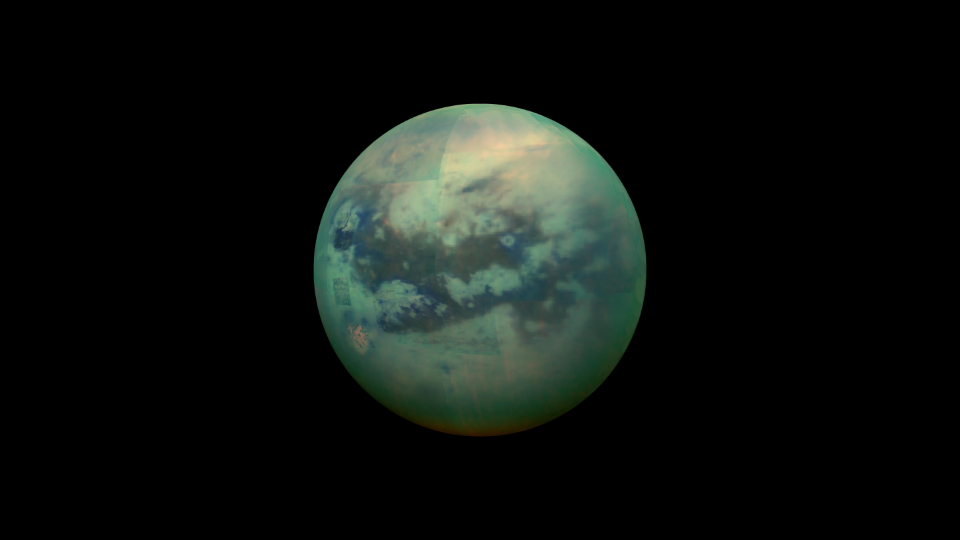Is there life on Titan?

Titan, Saturn’s largest moon and, hands down, one of the most intriguing moons of our solar system, has just become all the more fascinating. A recent paper has announced the discovery of acrylonitrile (more commonly known as Vinyl Cyanide) in Titan’s atmosphere. This molecule is a vital component for cell formation, therefore its presence is a strong indicator that life could well exist in one of Titan’s many lakes and seas.
After scouring through archival data collected in 2014 by ALMA (Atacama Large Millimeter/submillimeter Array), a set of 66 radio telescopes situated in the Atacama Desert of northern Chile, astronomers detected the three strongest rotational lines of C2H3CN - i.e. the unique electromagnetic fingerprint of vinyl cyanide.
Vinyl cyanide: why is it needed for life on Titan?
Vinyl cyanide is hypothesised to join together to form a cell membrane, the outer layer of a cell that creates a tiny enclosed environment. It's in here that it allows biochemical reactions to take place within the cell as well as protecting and encasing all the vital parts of the cell such as the nucleus.
On Earth, cell membranes are made of phospholipids, a molecules made of two parts – a water-loving (hydrophilic), oxygen rich head and a water-repelling (hydrophobic) set of tails. Due to a small charge imbalance the head of a phospholipid is 'polar', but the tail is not and is referred to as 'non-polar'.
If you chuck a load of these phospholipids in water the polar heads are attracted to one another and would join together, forming a sheet-like structure. Since the non-polar tails repel water, they would join end to end, meaning these two sheets would come together to form a bi-layer. It’s this phospholipid bi-layer that makes up the cell membranes here are on Earth.

However, thanks to a surface temperature of -179.5°C (-291.1°F), all water on Titan’s surface is frozen rock solid. Although there are liquid hydrocarbon lakes on Titan, at temperatures that low the phospholipid tails would also become far too rigid and stiff to form a flexible membrane. Then there is also a distinct lack of oxygen in the Titanean atmosphere meaning a cell-membrane made of phospholipids is simply not feasible.
Flexible and tough
Enter vinyl cyanide, a molecule whose tails are still flexible at extremely low temperatures, requires no oxygen whatsoever, and is made up of polar/non-polar components – an ideal candidate to make up that all important cell membrane.
Sign up for breaking news, reviews, opinion, top tech deals, and more.
In 2015, researchers at Cornell University attempted to model a cell membrane based on the chemistry and climate of Titan. The most stable membrane modelled was made of, you guessed it, vinyl cyanide. They called this potential alien membrane an “azotosome” and it’s the opposite of a phospholipid membrane, where the non-polar tails would stick in/out of the cell and the polar heads would join together to form a barrier.

It’s worth noting that vinyl cyanide has only been detected in Titan’s atmosphere and even then, there are only 2.8 vinyl cyanide molecules per billion. Given the low abundance, the chances of an azotosome forming in clouds 200km (124 miles) above the surface are pretty slim.
Thankfully, there is a way for vinyl cyanide to reach the surface and collect together – rainfall. Like Britain in summer, it rains a lot on Titan and the rainfall would transport the vinyl cyanide, along with many other molecules to Titan’s surface.
Countless images of lakes and seas have been returned from the Cassini mission, along with clear signs of valleys and rivers.
Rough calculations, found in the very paper that announced the detection of vinyl cyanide, estimate there may be as many 10 million azotosomes per cubic centimetre of liquid found in a Titanean lake. These calculations were based on rainfall into Ligeia Mare, a body of liquid methane 3000 square miles bigger than Lake Michigan and situated near Titan’s North Pole.
As a comparison, that’s about ten times more bacteria than is found in a cubic centimetre of coastal sea-water from one of earth’s many oceans.

This isn’t the first time that “building blocks for life” have been detected on Titan. Only recently, the Cassini satellite discovered a type of negatively charged molecule (known as carbon chain anions) floating around Titan’s atmosphere. These anions combine to form more complex organic molecules, similar to earliest forms of life in prehistoric earth.
Also in 2012, an experiment on Earth simulated the conditions and components of Titan’s atmosphere, bombarded it with UV radiation (the same amount that the Sun emits) and found the components of DNA and RNA had formed, along with several amino acids.
So we know have DNA, RNA, amino acids, complex organic molecules and now thanks to the recent ALMA discovery, a viable cell membrane to contain them all.
Now all this talk of DNA and cell membranes is still hypothetical, just because the building blocks for life are there, it doesn’t mean they will definitely put themselves together and find a way to become a living cell. This isn’t Jurassic Park.
Future missions
Although ground based telescopes and current exploratory missions have done a stellar job so far, the only way we can be 100% certain azotosomes (and potentially life) actually exist in the great lakes of Titan is to actually visit this distant moon again.
The issue is a) it takes on average six years to get to Saturn and b) there are currently no confirmed missions for further exploration of Titan.
That being said, there have been many mission proposals, the most promising of which is the TiME (Titan Mare Explorer) mission which suggests building a submarine to explore the depths of Titan’s lakes and seas.

In 2014, NASA awarded a Phase II grant to the project which allows for further development of the idea and to put in place conceptual designs of the craft.
So for now we can only wait for these missions to get the all clear and a further agonising few years travel time before we know for sure if there is indeed life on Titan.
If you want to know more about Titan, check out this video which covers all the basics, including how Titan formed, why it’s covered in a yellow haze and how cryovolcanoes plague it’s already unique surface.

Andy Roberts is a Technical Writer in the Cyber Security industry. He has a Masters in Physics from the University of Manchester and an extensive skill set that includes technical writing, creating and delivering training courses, data gathering expertise, various coding languages and video editing. Andy is a diligent, driven individual who is innovative and quick to learn.